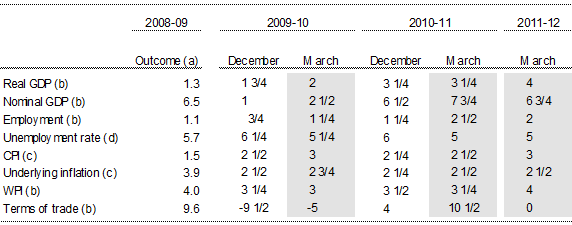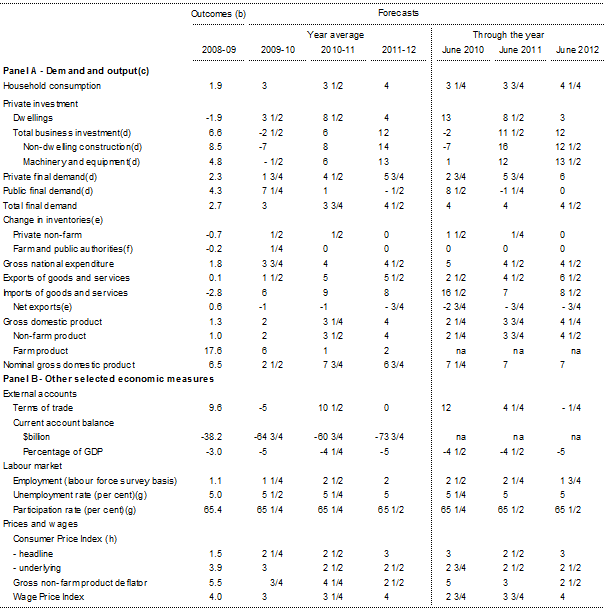Since December JEFG, the labour market has continued to surprise on the upside, suggesting greater strength in the economy than implied by outcomes for real GDP. The unemployment rate has fallen to 5.3 per cent and average hours have recovered somewhat, suggesting that spare capacity in the economy is diminishing.
It is puzzling that this labour market performance has been achieved in an economy growing at a rate we consider to be below trend, which is giving mixed messages about the strength of the underlying recovery and degree of excess capacity. The economy has also been supported by fiscal and monetary stimulus, suggesting some need for caution in assessing the strength of the economy in the forecast period. However, on balance the evidence suggests that a solid recovery is underway and that the economy is moving back to capacity more quickly than previously expected.
The global recovery is gathering pace putting upward pressure on prices for Australia's key commodity exports. This is expected to cause a substantial rise in Australia's terms of trade, which will boost incomes in the economy. Investment intentions in the mining industry are strong as companies seek to take advantage of the more positive outlook for commodity prices and improved credit conditions. The significant pipeline of work developing in the mining industry could see capacity constraints begin to bite, even with public sector stimulus being withdrawn over this period.
World GDP is expected to grow by 4 per cent in 2010 and 4¼ per cent in 2011. The US economic outlook continues to improve, albeit from a low base, reflecting stronger-than-expected household consumption and recent signs of a faster recovery in business investment. The outlook for emerging economies is strong, particularly in Asia. China is forecast to grow at a double-digit pace this year.
There are on-going risks to the global recovery. The process of financial deleveraging will continue to slow recovery in private demand in the major advanced economies, and the need to consolidate fiscal positions will place a drag on public demand. Global financial conditions are returning to normal, but risks around sovereign debt in Greece and other countries may continue to test confidence.
Australian real GDP is expected to grow by 2 per cent in 2009-10, compared with 1¾ per cent growth in the December JEFG, while the growth forecast for 2010-11 is unchanged at 3¼ per cent. An additional forecast year has been prepared for the March JEFG with real GDP in 2011-12 forecast to grow by 4 per cent. The economy is expected to be operating around capacity in 2011-12, much earlier than previously envisaged.
Table 1: Key Domestic Forecasts - March JEFG compared with December JEFG

(a) Calculated using original data.
(b) Year average.
(c) Through the year growth rate to the June quarter.
(d) June quarter.
Recent strong labour market outcomes suggest an economy approaching capacity. Stronger population growth and a higher participation rate are expected to slow down the decline in unemployment rate from here onwards. The unemployment rate is expected to fall to 5 per cent by the June quarter of 2010-11, consistent with the expectation that the labour market will reach capacity around that time. However, there is a risk that the unemployment rate could fall below 5 per cent over the forecast horizon. Strong labour demand will be required in the short term to keep pace with strong population growth and a rising participation rate. The participation rate is expected to increase to 65½ per cent over the forecast horizon, with the forecast taking into account underlying demographic trends.
A stronger labour market is expected to support a more positive outlook for household consumption. Consumer confidence has been bolstered by improved employment conditions and the rebound in household wealth from rising house prices and share values. While rising interest rates are expected to temper growth in dwelling investment, recent commencements and approvals data indicate continued strength in the pipeline which will support activity over most of 2010.
Strength in the global economy is expected to support a higher terms of trade. The terms of trade are forecast to increase by 10½ per cent in 2010-11 following a forecast fall of 5 per cent in 2009-10. This largely reflects expectations of substantial contract price rises for coal and iron ore in 2010. The terms of trade are assumed to be flat in 2011-12, with commodity prices remaining at high levels. Movements in commodity prices can be expected to add some volatility to the forecasts in the period ahead.
Strength in the resources sector is expected to spearhead a recovery in business investment in 2010-11 and 2011-12. The recovery will also be supported by a pick-up in underlying investment in other industries. Investment in new machinery and equipment was boosted in December quarter 2009 by the Small Business and General Business Tax Break — as this effect unwinds there is likely to be weakness in business investment in the near term.
While the private sector recovers, the effects of the Government's stimulus measure on infrastructure investment will unwind over the forecast period. New public final demand is forecast to grow by 7¼ per cent in 2009-10, 1 per cent in 2010-11 and to fall by ½ of a per cent in 2011-12. The forecast for 2011-12 takes into account the Commonwealth's fiscal targets. The withdrawal of the Government's fiscal stimulus has already begun. Through the year to the December quarter 2010, the withdrawal of stimulus is expected to detract around 1 percentage point from GDP growth.
The current account deficit (CAD) is forecast to widen to 5 per cent of GDP in 2009-10, less of a widening than at December JEFG, reflecting the stronger forecast for non-rural commodity export values. The CAD is expected to narrow to 4¼ per cent of GDP in 2010-11 due to higher export earnings, before widening to 5 per cent of GDP in 2011-12, driven by stronger import volumes and increased income outflows due to rising mining profits. Strong investment is likely to put pressure on the CAD further out.
A stronger economy is expected to see a pick up in inflation pressures compared with December JEFG, but with underlying CPI inflation in the middle of the RBA's target band. Prices and wages growth have eased in recent times, and the higher exchange rate has had a moderating effect on inflation. Underlying inflation is expected to be 2¾ per cent through the year to the June quarter 2010 and 2½ per cent through the year to the June quarters 2011 and 2012. The planned commencement of the Carbon Pollution Reduction Scheme from July 2011 is expected to add 0.4 percentage points to headline inflation through the year to June quarter 2012.
Table 2: Domestic economy forecasts(a)

(a) Percentage change on preceding year unless otherwise indicated.
(b) Calculated using orginal data.
(c) Chain volume measure.
(d) Excluding second-handasset sales from the public sector to the private sector.
(e) Percentage point contribution to growth in GDP.
(f) For presentation purposes, changes in inventories held by privatised marketing authorities are included with the inventories of the farm sector and public marketing authorities.
(g) The estimates in the final three columns are the forecast rates in the June quarter in 2010, 2011 & 2012 respectively.
(h) Through the year growth rate to June quarter for 2008-09
Source: ABS Cat. No. 5206.0, 5302.0, 6202.0, 6345.0, 6401.0, unpublished ABS data and Treasury.